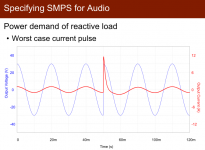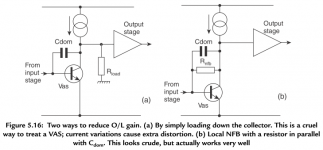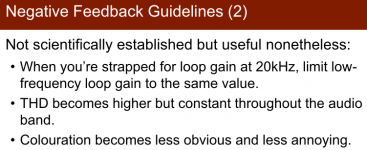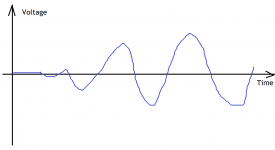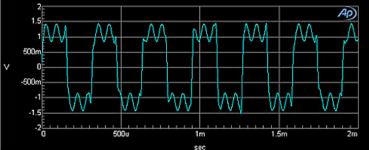Why did you not want to talk about Full power bandwidth? .
I would have no problem to discuss FPBW. But that was not the subject we were discussing.
Jan
a quote from Cheever's work on the differences between work on stationary signals and real musical:
"Bursts of noise detected within the first few tenths of a second in complex percussion sounds of a grand piano or harpsichord are key elements in the recognition, as shown in [37 p. 153]. The brain has a very complex mechanism for understanding multi-tone, but at a certain threshold of additional random vibrations (noises), the neural processing mechanism simply fails. I believe that the feedback itself creates levels of intermodulation distortion that modulate and otherwise obfuscate the noise bursts of musical instruments, leading to the subjective feeling that the sound is 'artificial'.
Gyula writes about the same (Radio amateur 1999_02-05): “We first apply signals from a generator to the amplifier input and only then we control the output signal. The entire measurement method itself is a stationary process: the signal has already been in the amplifier for a long time before it was subjected to precise analysis. The measurement process is long enough (for example, it takes a few seconds or even minutes), and its results refer to a steady state and characterize the continuous presence of a standard, well-defined measuring signal at the input. What happens when listening, and what is the difference here? Musical input the signal produced, for example, by a violinist chaotically sweeping his bow over the strings of a violin, or a guitarist fiercely tugging at the strings of a guitar, or a drummer pounding desperately on a drum, or an inspirational singing singer, may look like anything but a standard signal in 1 kHz. It (the input signal) changes in a pseudo-random way in amplitude, frequency, spectral composition and stereo characteristics. And the ears and the brain perfectly analyze the acoustic quality of such a signal and infallibly evaluate the impressions of additional sound signals that appeared in addition to (instead of) the original sound melody. We feel well that the music is playing, but there is also “something like that” that, although somehow associated with this music, but has nothing to do with it. "
Indeed, most of the amplifiers developed in the world with general feedback, but only rare of them meet the requirements of the reference amplification. If I understood this thread correctly and opened it to understand the secrets that are responsible for this. At one time, Graham tried to express his point of view and share his observations, but he was beaten to death. The branch has overgrown with a large amount of any flood without any arguments, it is simply impossible to find a rational grain, any proposals not described in textbooks are accepted with hostility ...
"Bursts of noise detected within the first few tenths of a second in complex percussion sounds of a grand piano or harpsichord are key elements in the recognition, as shown in [37 p. 153]. The brain has a very complex mechanism for understanding multi-tone, but at a certain threshold of additional random vibrations (noises), the neural processing mechanism simply fails. I believe that the feedback itself creates levels of intermodulation distortion that modulate and otherwise obfuscate the noise bursts of musical instruments, leading to the subjective feeling that the sound is 'artificial'.
Gyula writes about the same (Radio amateur 1999_02-05): “We first apply signals from a generator to the amplifier input and only then we control the output signal. The entire measurement method itself is a stationary process: the signal has already been in the amplifier for a long time before it was subjected to precise analysis. The measurement process is long enough (for example, it takes a few seconds or even minutes), and its results refer to a steady state and characterize the continuous presence of a standard, well-defined measuring signal at the input. What happens when listening, and what is the difference here? Musical input the signal produced, for example, by a violinist chaotically sweeping his bow over the strings of a violin, or a guitarist fiercely tugging at the strings of a guitar, or a drummer pounding desperately on a drum, or an inspirational singing singer, may look like anything but a standard signal in 1 kHz. It (the input signal) changes in a pseudo-random way in amplitude, frequency, spectral composition and stereo characteristics. And the ears and the brain perfectly analyze the acoustic quality of such a signal and infallibly evaluate the impressions of additional sound signals that appeared in addition to (instead of) the original sound melody. We feel well that the music is playing, but there is also “something like that” that, although somehow associated with this music, but has nothing to do with it. "
Indeed, most of the amplifiers developed in the world with general feedback, but only rare of them meet the requirements of the reference amplification. If I understood this thread correctly and opened it to understand the secrets that are responsible for this. At one time, Graham tried to express his point of view and share his observations, but he was beaten to death. The branch has overgrown with a large amount of any flood without any arguments, it is simply impossible to find a rational grain, any proposals not described in textbooks are accepted with hostility ...
I still suspect that the underlying problem is that when people hear something, they want an explanation for the underlying physical cause.
No; the underlying problems are one or more of the following:
- People attempting a physical cause explanation of their subjective assessments before they can confirm it has any support in the current physical reality.
- People attempting to push their subjective assessments down the throat of everybody else.
- Lacking any physical cause explanation for their subjective assessments, people invent a new physical reality (or in general knowledge) to support their views.
- Lacking the instruments (knowledge, education) to investigate a physical cause for their subjective assessments, people stick to what seems acceptable to them, which is usually far from the current physical reality.
Unfortunately it's occasionally difficult to separate an innocent ignorant (ignorance is not necessary a guilt) from one refusing to understand something, because the salary depends on his not understanding it.
Graham and I are criticized here: they say you can't suddenly feed the amplifier with a sinusoidal signal from zero and watch how the amplifier reacts to it. Here's an example from Bruno of reversing a signal at the top of a sine wave. The test shows that in order to amplify the signal without distortion, the output current margin is not less than tenfold.
Here are the statements of popular authors about the first pole.
From myself I can add:
the first pole above the audio range ensures the constancy of the loop gain in the audio band and, as a consequence, the constancy of the output impedance, which has a beneficial effect on the sound.
Here are the statements of popular authors about the first pole.
From myself I can add:
the first pole above the audio range ensures the constancy of the loop gain in the audio band and, as a consequence, the constancy of the output impedance, which has a beneficial effect on the sound.
Attachments
they say you can't suddenly feed the amplifier with a sinusoidal signal from zero and watch how the amplifier reacts to it.
Of course you can. It's just that it is not an audio test because the signal is not an audio signal.
Maybe it will help your understanding if I repeat it a few times?
Of course you can. It's just that it is not an audio test because the signal is not an audio signal.
Of course you can. It's just that it is not an audio test because the signal is not an audio signal.
Of course you can. It's just that it is not an audio test because the signal is not an audio signal.
Of course you can. It's just that it is not an audio test because the signal is not an audio signal.
Of course you can. It's just that it is not an audio test because the signal is not an audio signal.
Of course you can. It's just that it is not an audio test because the signal is not an audio signal.
Jan
Of course you can. It's just that it is not an audio test because the signal is not an audio signal.
Maybe it will help your understanding if I repeat it a few times?
Of course you can. It's just that it is not an audio test because the signal is not an audio signal.
Of course you can. It's just that it is not an audio test because the signal is not an audio signal.
Of course you can. It's just that it is not an audio test because the signal is not an audio signal.
Of course you can. It's just that it is not an audio test because the signal is not an audio signal.
Of course you can. It's just that it is not an audio test because the signal is not an audio signal.
Of course you can. It's just that it is not an audio test because the signal is not an audio signal.
Jan
here's another example
Apex A40 fundamental improvement. (Sandy)
Current feedback amplifiers have great potential. I also made my own version of a similar amplifier. In such amplifiers, the output impedance is close to ohmic and to stabilize the operation, a small inductance is enough, and often it is not needed at all.
Hi Petrov,
the claimed amplifier design of yours you said having published in Russian publication Radio (А.Петров, УМЗЧ с токовой обратной связью, Радио 2018 No6, с.10) as mentioned in your PDF document attached, did you also build and measure it in real life, and if so do you have any pictures from the build and measurements to share with us?
Here it is again, Im sure you didnt understand it the first 100 times. Read it a couple times.
Jan, have you hit your head on the brick wall enough yet? Im pretty sure anybody slowing down to look at this car wreck will realize who the buffoon is. This is not even entertaining anymore, good luck, Im done.
they say you can't suddenly feed the amplifier with a sinusoidal signal from zero and watch how the amplifier reacts to it.
Of course you can. It's just that it is not an audio test because the signal is not an audio signal.
Maybe it will help your understanding if I repeat it a few times?
Of course you can. It's just that it is not an audio test because the signal is not an audio signal.
Of course you can. It's just that it is not an audio test because the signal is not an audio signal.
Of course you can. It's just that it is not an audio test because the signal is not an audio signal.
Of course you can. It's just that it is not an audio test because the signal is not an audio signal.
Of course you can. It's just that it is not an audio test because the signal is not an audio signal.
Of course you can. It's just that it is not an audio test because the signal is not an audio signal.
Jan
Jan, have you hit your head on the brick wall enough yet? Im pretty sure anybody slowing down to look at this car wreck will realize who the buffoon is. This is not even entertaining anymore, good luck, Im done.
Off:
Please guys let's concentrate on the target and on the original topic.
It's so sad we cannot work together. And I don't mean to agree on everything
but to build this thing up from the different ends in a constructive way.
All the mental energy we use for personal figthing against each other could go
on the topic itself. And please let's not debate about how stupid and
non-sense this idea is per se. Who doesn't see it interesting please do
not post and who has any idea to develop it further please post.
Now 80% of the posts are just off-topic "just beacause" attacks and criticism.
I also beleive that exploring this together (believers vs non-belivers) could
be a very good method but not in every way: please don't criticise per se.
Rather guide the belivers for an even better and precise concept and way to do this right.
I don't think that this FCD is so trivially a wrong way that anybody should
"demolish" it completely in such an early stage. Let's take it as an idea and an experiment.
I think it has a potential and can come up with a new way of analyzing an amplifier.
Let's try to build up this idea and topic together with good and constructive content.
On:
For a start let's develop a test method and signal which is acceptable for "all".
If the a full regular and continuous, "steady state" sinus is on the one end and the
extreme "starting-from-zero" sine wave is on the other, let's meet somewhere between.
What kind of signal and distortion measurement (or rather calculation at the beginning)
would be acceptable to test an amplifiers inertia against a changing stimulation?
For example starting it from zero but gradually increasing the amplitude to the max?
Like hitting a cymbal?
What if we increase it as fast as it can be? What about a test signal like I attached.
And please allow some speed (slew rate) margin also somewhat above the normal audio band.
As it's also very common to use a square wave for testing amplifier, why not to use a special
waveform for this test as well? Square wave is also not within the normal audio band.
And again: the reason to that is just to MAGNIFY the effect as it also COULD affect
the normal audio band.
But the main point again in this approach is not the extreme / unreal fast test signal but
the fact that the amplifier is tested in "real time" within a short time period and we check
for the amplifiers adaption capability (speed and cleanness) to this changing state vs test it
with a regular and continuous waveform in average after a lot of time let the system settle.
The exact opposite is on target: let's test this settlement process from the very begining.
Please guys let's concentrate on the target and on the original topic.
It's so sad we cannot work together. And I don't mean to agree on everything
but to build this thing up from the different ends in a constructive way.
All the mental energy we use for personal figthing against each other could go
on the topic itself. And please let's not debate about how stupid and
non-sense this idea is per se. Who doesn't see it interesting please do
not post and who has any idea to develop it further please post.
Now 80% of the posts are just off-topic "just beacause" attacks and criticism.
I also beleive that exploring this together (believers vs non-belivers) could
be a very good method but not in every way: please don't criticise per se.
Rather guide the belivers for an even better and precise concept and way to do this right.
I don't think that this FCD is so trivially a wrong way that anybody should
"demolish" it completely in such an early stage. Let's take it as an idea and an experiment.
I think it has a potential and can come up with a new way of analyzing an amplifier.
Let's try to build up this idea and topic together with good and constructive content.
On:
For a start let's develop a test method and signal which is acceptable for "all".
If the a full regular and continuous, "steady state" sinus is on the one end and the
extreme "starting-from-zero" sine wave is on the other, let's meet somewhere between.
What kind of signal and distortion measurement (or rather calculation at the beginning)
would be acceptable to test an amplifiers inertia against a changing stimulation?
For example starting it from zero but gradually increasing the amplitude to the max?
Like hitting a cymbal?
What if we increase it as fast as it can be? What about a test signal like I attached.
And please allow some speed (slew rate) margin also somewhat above the normal audio band.
As it's also very common to use a square wave for testing amplifier, why not to use a special
waveform for this test as well? Square wave is also not within the normal audio band.
And again: the reason to that is just to MAGNIFY the effect as it also COULD affect
the normal audio band.
But the main point again in this approach is not the extreme / unreal fast test signal but
the fact that the amplifier is tested in "real time" within a short time period and we check
for the amplifiers adaption capability (speed and cleanness) to this changing state vs test it
with a regular and continuous waveform in average after a lot of time let the system settle.
The exact opposite is on target: let's test this settlement process from the very begining.
Attachments
Last edited:
OK - so how do you analyse the result on the output when exposing a DUT input to your suggested stimuli? And please do add time & voltage to your picture.
//
//
But the main point again in this approach is not the extreme / unreal fast test signal but the fact that the amplifier is tested in "real time" within a short time period and we check for the amplifiers adaption capability (speed and cleanness) to this changing state vs test it
with a regular and continuous waveform in average after a lot of time let the system settle. The exact opposite is on target: let's test this settlement process from the very beginning.
So let me see if I get this. You wish to re-develop testing methods we've been using and are documented for the last, ohh, 50 years?
Is this where you wish us to spend our time and energy?
Would it not be far more efficiently to learn the existing methods to know what we are talking about, rather than trying to re-live history?
This learning can be done with an ancient but very advanced technique called 'study'.
Let me give you a head start: look up 'DIM30 test signal' and the measurements done on the amp response to it. It is a technique used to measure the non-linearity of a device, and it’s designed to be particularly sensitive to distortions produced during transient conditions typical of audio program material.
Jan
Attachments
Last edited:
Ok, thanks you're right -> the image is edited (I added the arrows and time dimensions the the axels)!OK - so how do you analyse the result on the output when exposing a DUT input to your suggested stimuli? And please do add time & voltage to your picture.
> how do you analyse the result
Well, that's a good question, please help! 🙂
The most simple way I guess is just to substract the (input x gain) - (output) signal and check wherem when and how it differs the most.
Do we need/have any better method or formula to begin with?
I'm sorry then: so is there a way then we can easily perform such a test the way I described?So let me see if I get this. You wish to re-develop testing methods we've been using and are documented for the last, ohh, 50 years?
How it works? Can we simulate (calculate) it as well?
And is there a real life measuring framework (device, numerical results, etc) as well?
Then why we didn't talk about this instead the THD method? 🙂
Thanks!
Thanks Jan!Let me give you a head start: look up 'DIM30 test signal' and the measurements done on the amp response to it.
I reply to this separately as you wrote this part after I replied to your original post.
So: as I see this method also uses a steady and continuous test signal.
I mean it's definitely better then the regualr sine wave for testing inertia
but it is not so cruel as a stimulation and signal from a complete resting state.
Can you agree?
A basic question: just because our ears hear till 20kHz is it sure that it
is enough for an electrical (and hifi) reproduction system to only have the
speed (and power) to reproduce a regular and natural 20kHz sine wave perfectly?
It doesn't need any margin or surplus to take all the possible "curves"
(rapid changes, irregularites) right when reproducing a complex and mixed
audio signal which contains a lot of sounds (audio frequencies) together?
And again: under speed I don't necessarily mean "just" the slope or the slew
rate of a grabbed section of that signal but the complexity (or irregularity)
of the changes vs a sine wave (specially focusing on the power/work/energy
to take these curves).
A human-sense based metaphorical example: if we grab a heavy object in our
hand (let's say a 5kg weight) and the target is just to move it up and down
I think it's obvious that moving it follwing a regular sine wave (or even a
square wave like special) kind of motion is much easier (and natural) than
pulling and pushing it randomly.
And (here is the crucial point for me): itt will be a harder (and so a lame
and "delayed" copy of movement) even if the "moving speed" is all the time
lower than it is the max as when doing it in the regular sine wave way.
is enough for an electrical (and hifi) reproduction system to only have the
speed (and power) to reproduce a regular and natural 20kHz sine wave perfectly?
It doesn't need any margin or surplus to take all the possible "curves"
(rapid changes, irregularites) right when reproducing a complex and mixed
audio signal which contains a lot of sounds (audio frequencies) together?
And again: under speed I don't necessarily mean "just" the slope or the slew
rate of a grabbed section of that signal but the complexity (or irregularity)
of the changes vs a sine wave (specially focusing on the power/work/energy
to take these curves).
A human-sense based metaphorical example: if we grab a heavy object in our
hand (let's say a 5kg weight) and the target is just to move it up and down
I think it's obvious that moving it follwing a regular sine wave (or even a
square wave like special) kind of motion is much easier (and natural) than
pulling and pushing it randomly.
And (here is the crucial point for me): itt will be a harder (and so a lame
and "delayed" copy of movement) even if the "moving speed" is all the time
lower than it is the max as when doing it in the regular sine wave way.
it is not so cruel as a stimulation and signal from a complete resting state.
Can you agree?
DIM30 is a very realistic audio-like signal. Which is what we wanted, no?
Jan
Ok, thanks you're right -> the image is edited (I added the arrows and time dimensions the the axels)!
You got to be kidding.
//
I'm sorry then: so is there a way then we can easily perform such a test the way I described?
How it works? Can we simulate (calculate) it as well?
And is there a real life measuring framework (device, numerical results, etc) as well?
Then why we didn't talk about this instead the THD method? 🙂
Thanks!
Post 431 has the answer to the 1st part.
The reason is everyone talks about the THD test is because it is simple to do and understand.
Going beyond that takes effort and investment in time and equipment.
Jan
...
but it is not so cruel as a stimulation and signal from a complete resting state.
...
So, how many times on a CD record, with 10 tracks, do this situation arise - as you see it?
//
20kHz BW may not be quite enough to capture successive transients within certain sounds, like a cymbal crash for example. There was a discussion about this on the blowtorch thread IIRC. It's possible that the temporal response of the ear may detect a difference but I'm not aware anything has been proven.
- Home
- Amplifiers
- Solid State
- First cycle distortion - Graham, what is that?
